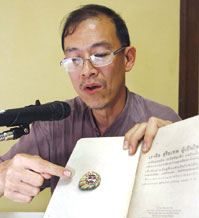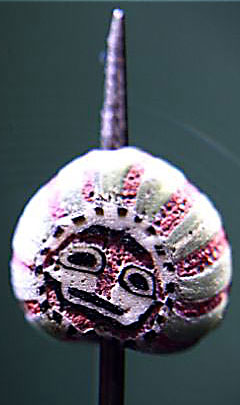|
In the middle of March 2009, there was strange news in Thailand. A thief stole a small bead called "Surya Deva", which is one centimeter in diameter, from the Bead and Beyond exhibition in Museum Siam, Bangkok.
After two weeks, the thief returned the bead and wrote a letter of apology. "I'm sorry to cause trouble for all of you. I would like to return this, so that everyone is happy. My sincere apology." Although the stolen bead came back, this wrongdoing remains criminal offence. The police must continue to investigate, search and capture the criminal.
The one centimeter-wide bead created of glass mosaic called "Surya Deva" can make happiness in the critical political conflicts between the current yellow and the red protests.
After the color and appearance of the bead had been tested, the museum's officers believed that this was the stolen "Surya Deva" bead.
In ancient times, beads were used as the currency for trading and this treasure is regarded as beautiful historical evidence.
The bead owner is Doctor Bancha Pongpanit.  He confirmed that the returned bead was the same bead which disappeared and denied the accusation that he promoted himself with this incident. He insisted he is a collector and not an investor. The bead's value is actually higher than its selling price. He confirmed that the returned bead was the same bead which disappeared and denied the accusation that he promoted himself with this incident. He insisted he is a collector and not an investor. The bead's value is actually higher than its selling price.
These beads are a national treasure. Mr. Teera Salakphet, the minister of culture, said that this it is a good thing to have the bead back.
For a long time, I have insisted that the ancient beads and other ancient objects should be registered. If they are lost or stolen, it would be much easier to get them back.
Surya Deva beads were found in Klongtom, Krabi province. The age of the beads are not less than 2,000 years.  Some people think these beads are sacred and rare. It is believed that the owners will be fortunate and have good health. Some people think these beads are sacred and rare. It is believed that the owners will be fortunate and have good health.
When the book "Roy Look Pad" was published the popularity of beads was revived once again. A bead collector said that 500 years before Christ there were glass-making villages on the Mediterranean coast in Syria and Lebanon and neighboring areas. Beads in the shape of human faces were used to buy goods and even freedom.
In Thailand, beads were used to trade for ivory, leather, eaglewood and zinc minerals which made bronze. The fact that Aryans from India sailed to Southeast Asia proved that these beads were from other regions and not from Thailand, even though they were discovered there.
Along with books, T-shirts printed in beads pattern will be sold this April to greet the incoming summer.
|

